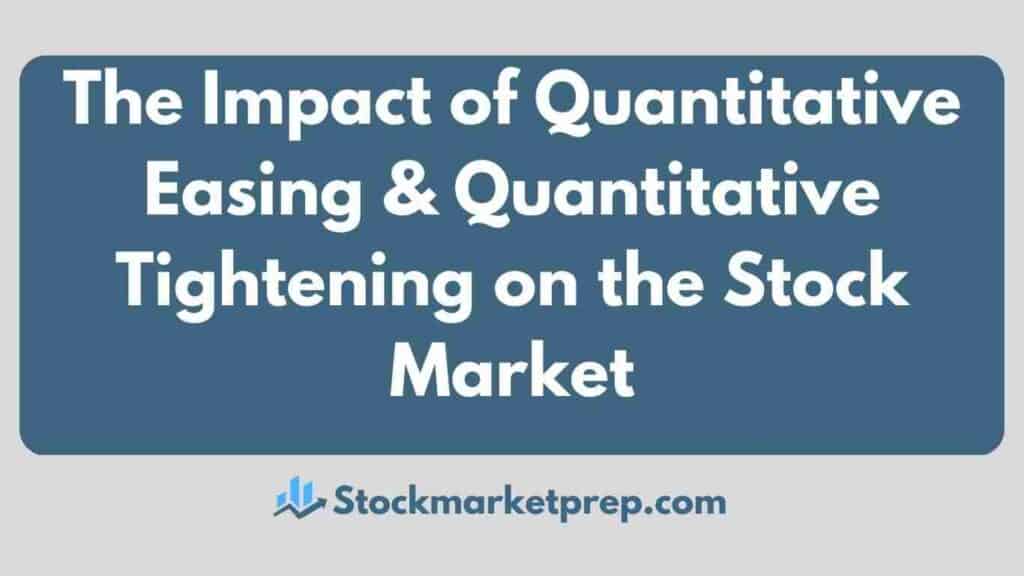
Table of Contents
Toggle1. Introduction
A. Explanation of Quantitative Easing and Quantitative Tightening
Quantitative easing (QE) and quantitative tightening (QT) are monetary policy tools used by central banks to influence the economy. QE involves the purchase of government bonds or other securities by the central bank, increasing the money supply and lowering interest rates. QT involves the selling of these securities, decreasing the money supply and raising interest rates.
B. Importance of Understanding the Impact of QE and QT on the Stock Market
The stock market is closely tied to monetary policy, and the impact of QE and QT can have significant implications for investors. Understanding the impact of these tools on the stock market is essential for making informed investment decisions.
C. Brief Overview of the Article
This article will provide a comprehensive analysis of the impact of QE and QT on the stock market, including historical examples and the current state of these policies.
2. Quantitative Easing
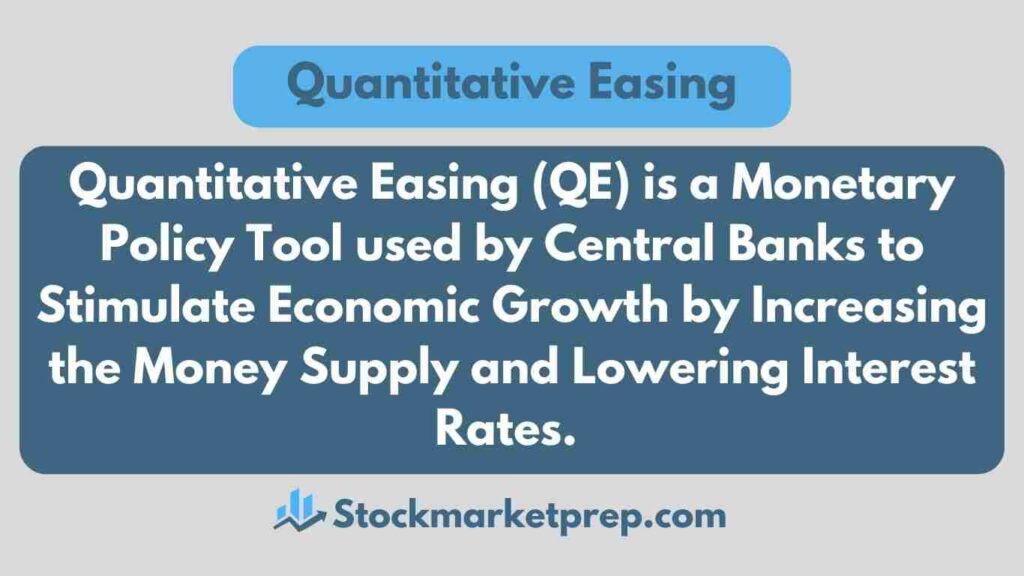
A. Definition and Explanation of Quantitative Easing
Quantitative easing (QE) is a monetary policy tool used by central banks to stimulate economic growth by increasing the money supply and lowering interest rates. When a central bank implements QE, it buys government bonds or other securities from the market, effectively increasing the money supply and providing banks with more cash reserves. This increased liquidity in the market allows for increased lending and investment, ultimately spurring economic growth.
B. Historical Examples of Quantitative Easing
Historical examples of QE include the policies implemented by the US Federal Reserve in response to the 2008 financial crisis and the European Central Bank’s QE program, which began in 2015. In the US, the Federal Reserve implemented three rounds of QE between 2008 and 2014, buying trillions of dollars worth of government bonds and mortgage-backed securities. The ECB’s QE program involved purchasing large quantities of government bonds and corporate bonds in an effort to boost economic growth in the Eurozone.
C. Impact of Quantitative Easing on the Stock Market
The impact of QE on the stock market can be positive, resulting in an increase in stock prices and liquidity. When the central bank buys bonds, it increases demand for these securities, causing bond prices to rise and yields to fall. As a result, investors may turn to the stock market in search of higher returns, causing stock prices to rise. Additionally, increased liquidity in the market can provide a boost to the economy, leading to increased consumer and business spending.
However, QE can also have an impact on inflation and interest rates. When the money supply increases rapidly, it can lead to inflation as prices rise due to increased demand. Central banks may counteract this by raising interest rates to slow down economic growth and prevent inflation from getting out of control. Therefore, investors need to be aware of the potential inflationary effects of QE and monitor interest rate changes closely.
Overall, QE can have a significant impact on the stock market, providing a boost to economic growth and leading to increased stock prices and liquidity. However, investors need to be aware of the potential risks of inflation and interest rate changes associated with QE and monitor central bank policies closely.
3. Quantitative Tightening
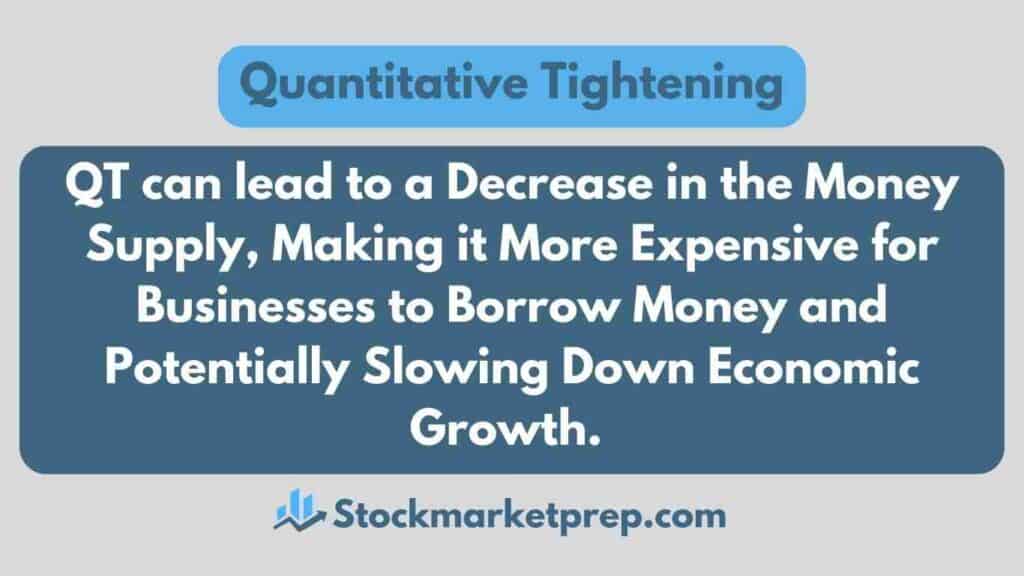
A. Definition and Explanation of Quantitative Tightening
QT can lead to a decrease in the money supply, making it more expensive for businesses to borrow money and potentially slowing down economic growth. This can result in a decrease in corporate profits and lead to a decrease in stock prices. Additionally, as interest rates rise, investors may shift their investments away from stocks and towards fixed-income securities, leading to a decrease in demand for stocks and further decreasing stock prices. The impact of QT on inflation and interest rates can also have significant effects on the economy and the stock market.
B. Historical Examples of Quantitative Tightening
Historical examples of quantitative tightening (QT) include the US Federal Reserve’s gradual reduction of its bond purchases in 2018, which marked the beginning of the QT phase after years of QE. The Fed’s balance sheet had grown to over $4 trillion due to QE, and in 2018, it started to gradually reduce its bond purchases by $10 billion per month. In 2019, the Fed halted its QT program.
The European Central Bank (ECB) also implemented a QT program in 2018 by ending its QE program. The ECB had been purchasing bonds since 2015 as part of its QE program, which had helped to stimulate the eurozone’s economy. However, in 2018, the ECB announced that it would end its bond-buying program, which was seen as a signal that the central bank was moving towards QT.
Other central banks, such as the Bank of Japan, have also implemented QT programs in the past. However, it’s worth noting that the impact of QT can vary depending on the economic conditions of each country and the specific policies implemented by each central bank.C. Impact of quantitative tightening on the stock market
QT can have a negative impact on the stock market, resulting in a decrease in stock prices and liquidity. It can also impact inflation and interest rates.
4. Comparison of QE and QT
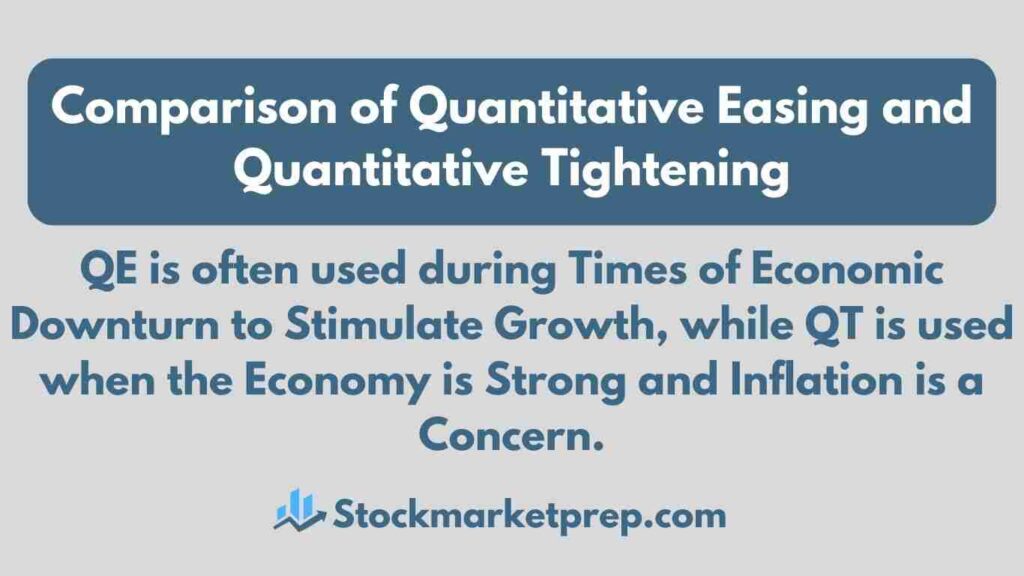
A. Differences between QE and QT
The main difference between QE and QT is the direction of monetary policy. QE involves central banks buying government bonds or other assets to increase the money supply, while QT involves the selling of assets to reduce the money supply. Additionally, QE is often used during times of economic downturn to stimulate growth, while QT is used when the economy is strong and inflation is a concern.
B. Similarities between QE and QT
Despite their differences, QE and QT share some similarities. Both tools are used by central banks to influence the money supply and interest rates. They also have an impact on financial markets, including the stock market.
C. Impact on the Stock Market
The impact of QE and QT on the stock market can be significant. QE can lead to an increase in stock prices and liquidity, while QT can lead to a decrease in stock prices and liquidity. Additionally, the announcement of QE or QT can impact market sentiment, causing investors to adjust their strategies accordingly. Overall, the relationship between QE and QT and the stock market is complex and requires careful monitoring.
5. The Current State of QE and QT

A. Overview of the Current state of QE and QT
Currently, several central banks around the world are still implementing QE, including the US Federal Reserve, the Bank of Japan, and the European Central Bank. However, some central banks have started to implement QT, such as the US Federal Reserve’s decision to gradually reduce its balance sheet.
B. Impact on the Stock Market
The current state of QE and QT has had a significant impact on the stock market. For example, the prolonged QE policies by the US Federal Reserve and the European Central Bank have contributed to a rise in stock prices. On the other hand, the announcement of QT by the US Federal Reserve in 2018 led to a sharp decline in the stock market.
6. Strategies for Investors
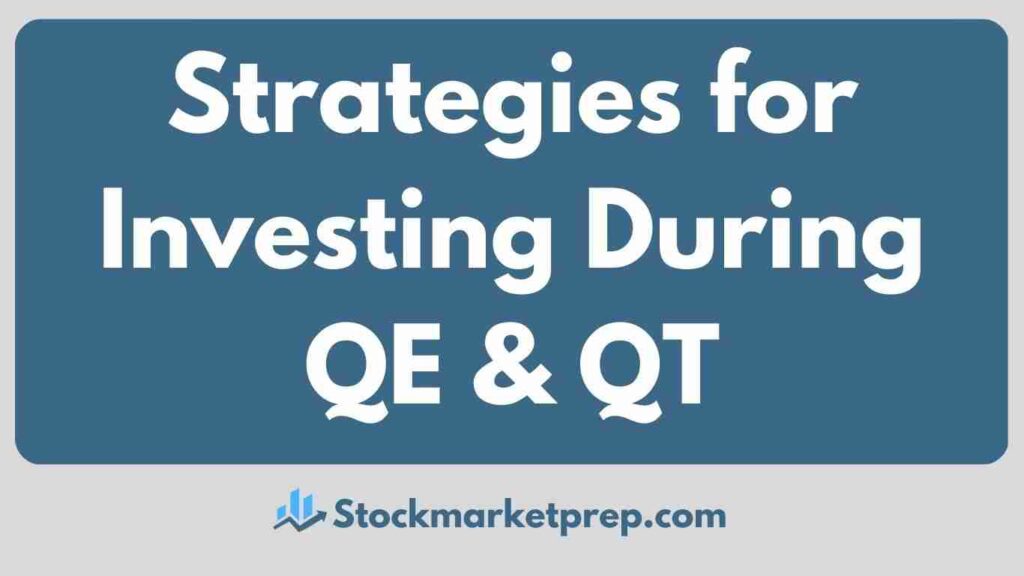
A. Strategies for Investing During QE
Investors may consider investing in stocks during QE to take advantage of the increase in liquidity and potential increase in stock prices. However, it’s important to keep in mind that the stock market can be volatile and unpredictable, so it’s important to diversify your investments and do your research before making any investment decisions.
Investors may also consider investing in assets that are expected to benefit from QE, such as commodities or real estate. Additionally, investors may consider investing in emerging markets, as they may see increased investment flows during QE.
B. Strategies for Investing During QT
During QT, investors may consider investing in bonds or defensive stocks to reduce risk exposure. Defensive stocks are companies that provide essential goods or services that are always in demand, such as utilities or healthcare. These companies are less likely to be affected by economic downturns and may provide a more stable investment option during QT.
Investing in bonds is also a popular strategy during QT as interest rates tend to rise during this period, which can make bonds more attractive as they offer fixed interest payments. However, investors should be aware that rising interest rates can also cause bond prices to fall, so it’s important to carefully consider the types of bonds being invested in and the potential risks involved.
C. Risks and Benefits of Investing During QE and QT
Investing during QE and QT carries both risks and benefits that investors should be aware of.
During QE, the benefits include increased liquidity and the potential for higher stock prices, while the risks include the potential for inflation and interest rate increases.
During QT, the benefits include the potential for higher interest rates and reduced inflation, while the risks include decreased liquidity and lower stock prices.
Investors should carefully consider their investment strategies and risk tolerance before investing during QE and QT. It may be beneficial to diversify portfolios and to seek the advice of a financial advisor.
7. Conclusion
In conclusion, QE and QT are two monetary policy tools used by central banks to influence the economy, with significant implications for the stock market. QE can result in an increase in stock prices and liquidity, while QT can lead to a decrease in stock prices and liquidity.
The impact of these policies on the stock market is complex and requires careful monitoring, particularly as central banks around the world continue to implement QE and, in some cases, move towards QT. Investors need to be aware of the potential risks and benefits of investing during QE and QT, and carefully consider their investment strategies and risk tolerance.
Monitoring central bank policies and seeking the advice of a financial advisor can help investors make informed decisions and navigate the complexities of QE and QT.
We hope you found this article informative and useful in understanding the impact of quantitative easing and tightening on the stock market. Do you have any additional insights or experiences to share? Please feel free to leave a comment below and share this article on social media to continue the conversation with your friends and colleagues. Your feedback and engagement are greatly appreciated!
8. Questions & Answers
Q: What is quantitative easing?
A: Quantitative easing is a monetary policy tool used by central banks to stimulate economic growth by increasing the money supply and lowering interest rates.
Q: What is the impact of quantitative easing on the stock market?
A: The impact of QE on the stock market can be positive, resulting in an increase in stock prices and liquidity. However, QE can also have an impact on inflation and interest rates.
Q: What is quantitative tightening?
A: Quantitative tightening (QT) involves the selling of government bonds or other securities by the central bank, decreasing the money supply and raising interest rates.
Q: What is the impact of quantitative tightening on the stock market?
A: QT can have a negative impact on the stock market, resulting in a decrease in stock prices and liquidity. It can also impact inflation and interest rates.
Q: What are some strategies for investing during quantitative easing?
A: Investors may consider investing in stocks, assets that are expected to benefit from QE, or emerging markets.
Q: What are some strategies for investing during quantitative tightening?
A: During QT, investors may consider investing in bonds or defensive stocks to reduce risk exposure.
Q: What are the risks and benefits of investing during quantitative easing and tightening?
A: The benefits include increased liquidity and the potential for higher stock prices during QE, while the benefits during QT include the potential for higher interest rates and reduced inflation. However, both QE and QT carry risks, including inflation and interest rate increases during QE, and decreased liquidity and lower stock prices during QT.